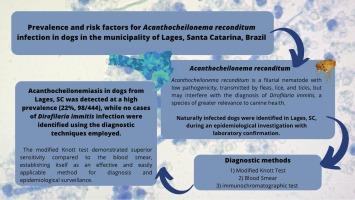巴西圣卡塔琳娜州Lages市犬棘足线虫感染的流行率和危险因素
IF 1.4
Q3 PARASITOLOGY
Veterinary parasitology, regional studies and reports
Pub Date : 2025-10-01
DOI:10.1016/j.vprsr.2025.101352
引用次数: 0
摘要
棘足线虫是一种由节肢动物(跳蚤、虱子和蜱)传播的丝状线虫,主要寄生于犬科动物的皮下组织,但也存在于肾周脂肪中。在诊断时很容易将一种致病性更强的线虫与粘连丝虫混淆,因此粘连丝虫的临床相关性常常被掩盖。在圣卡塔琳娜州(SC)的Lages和巴西的圣卡塔琳娜高原均未发现粘连丝虫。然而,当地实验室在犬血样本中观察到微丝蚴,并要求圣卡塔琳娜州立大学兽医寄生虫学实验室进行鉴定。形态鉴定证实了褐家蚕幼虫。本研究旨在确定拉格斯犬中棘球绦虫感染的流行情况并评估危险因素。总共从不同社区的狗身上收集了444份血液样本,同时对外套进行了外寄生虫检查。调查对象的年龄、性别、来源、品种、体外寄生虫控制情况、有无临床症状等,并通过流行病学调查问卷对其感染危险因素进行评估。采用血液涂片、改良Knott试验、免疫层析法对血样进行分析。改良Knott试验检出率为22.07%(98/444),血涂片检出率仅为4.27%(19/444)。所有评估的样本在Knott试验中均未显示出与D. immitis相容的特征,并且在免疫层析试验中均检测为阴性,表明缺乏该物种的循环抗原。35.58%(158/444)的动物被检出体外寄生虫,与地底单胞杆菌感染的危险因素无普遍关联。被寄生动物中以管翅目为主,93.02%的被寄生动物中存在管翅目昆虫,其存在与被寄生动物感染棘毛螨有显著的相关性(p = 0.003)。本研究证实了拉格斯地区没有布氏弓形虫,并强调了布氏弓形虫的高流行率,强调了人畜共患的可能性和进一步调查的必要性。本文章由计算机程序翻译,如有差异,请以英文原文为准。

Prevalence and risk factors for Acanthocheilonema reconditum infection in dogs in the municipality of Lages, Santa Catarina, Brazil
Acanthocheilonema reconditum (syn. Dipetalonema reconditum) is a filarial nematode transmitted by arthropods (fleas, lice, and ticks), primarily parasitizing the subcutaneous tissue of canids, but also found in perirenal fat. The clinical relevance of A. reconditum is often overshadowed by Dirofilaria immitis, a more pathogenic nematode with which it can be easily confused during diagnosis There are no reports of D. immitis in Lages, Santa Catarina (SC), neither in the Santa Catarina Plateau, Brazil. However, local laboratories observed microfilariae in canine blood samples and requested identification by the Veterinary Parasitology Laboratory of the State University of Santa Catarina. Morphological evaluation confirmed A. reconditum larvae. This study aimed to determine the prevalence of A. reconditum infection and assess risk factors in dogs from Lages. A total of 444 blood samples were collected from dogs in different neighborhoods, with simultaneous coat inspection for ectoparasites. Information on age, sex, origin, breed, ectoparasite control, and presence or absence of clinical signs was obtained through an epidemiological questionnaire to assess risk factors for A. reconditum infection. Blood samples were analyzed by blood smear, modified Knott's test, and immunochromatographic test. The prevalence of A. reconditum was 22.07 % (98/444) by the modified Knott's test, whereas the blood smear detected only 4.27 % (19/444). None of the evaluated samples showed characteristics compatible with D. immitis in the Knott's test, and all tested negative in the immunochromatographic test, indicating the absence of circulating antigen of this species. Ectoparasites were found in 35.58 % (158/444) of the animals, with no general association as a risk factor for A. reconditum infection. Among ectoparasites, Siphonaptera predominated, present in 93.02 % of parasitized animals, with a significant association between Pulex irritans presence (p = 0.003) and A. reconditum infection. This study confirmed the absence of D. immitis in Lages and highlighted a high prevalence of A. reconditum, underscoring the zoonotic potential and the need for further investigations.
求助全文
通过发布文献求助,成功后即可免费获取论文全文。
去求助
来源期刊
CiteScore
2.90
自引率
7.10%
发文量
126
审稿时长
97 days
期刊介绍:
Veterinary Parasitology: Regional Studies and Reports focuses on aspects of veterinary parasitology that are of regional concern, which is especially important in this era of climate change and the rapid and often unconstrained travel of people and animals. Relative to regions, this journal will accept papers of the highest quality dealing with all aspects of disease prevention, pathology, treatment, epidemiology, and control of parasites within the field of veterinary medicine. Also, case reports will be considered as they add to information related to local disease and its control; such papers must be concise and represent appropriate medical intervention. Papers on veterinary parasitology from wildlife species are acceptable, but only if they relate to the practice of veterinary medicine. Studies on vector-borne bacterial and viral agents are suitable, but only if the paper deals with vector transmission of these organisms to domesticated animals. Studies dealing with parasite control by means of natural products, both in vivo and in vitro, are more suited for one of the many journals that now specialize in papers of this type. However, due to the regional nature of much of this research, submissions may be considered based upon a case being made by the author(s) to the Editor. Circumstances relating to animal experimentation must meet the International Guiding Principles for Biomedical Research Involving Animals as issued by the Council for International Organizations of Medical Sciences (obtainable from: Executive Secretary C.I.O.M.S., c/o W.H.O., Via Appia, CH-1211 Geneva 27, Switzerland).

 求助内容:
求助内容: 应助结果提醒方式:
应助结果提醒方式:


